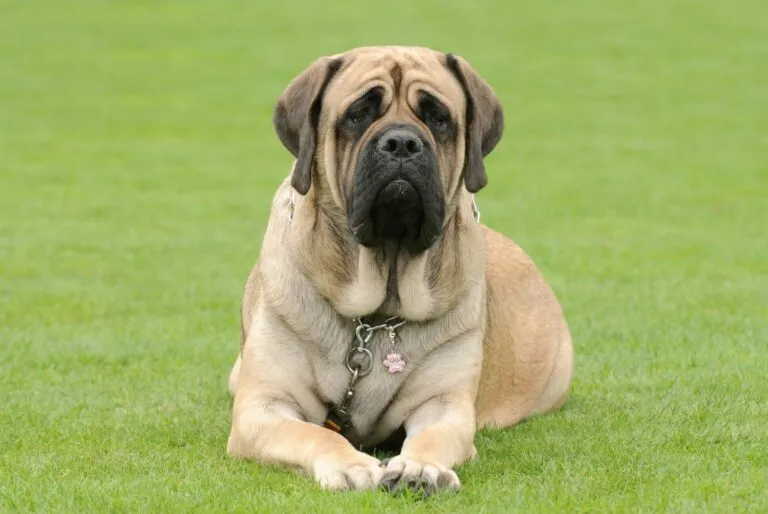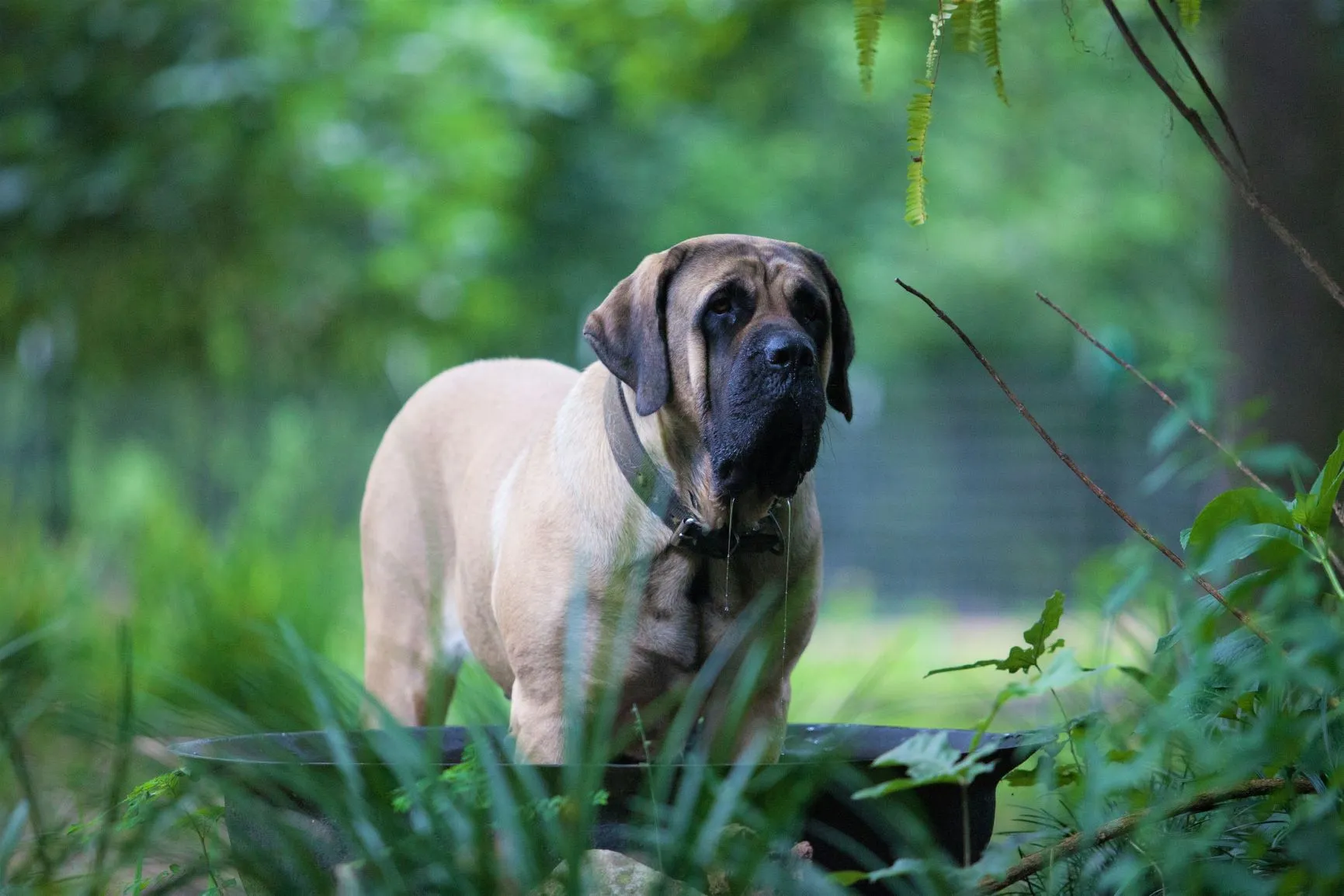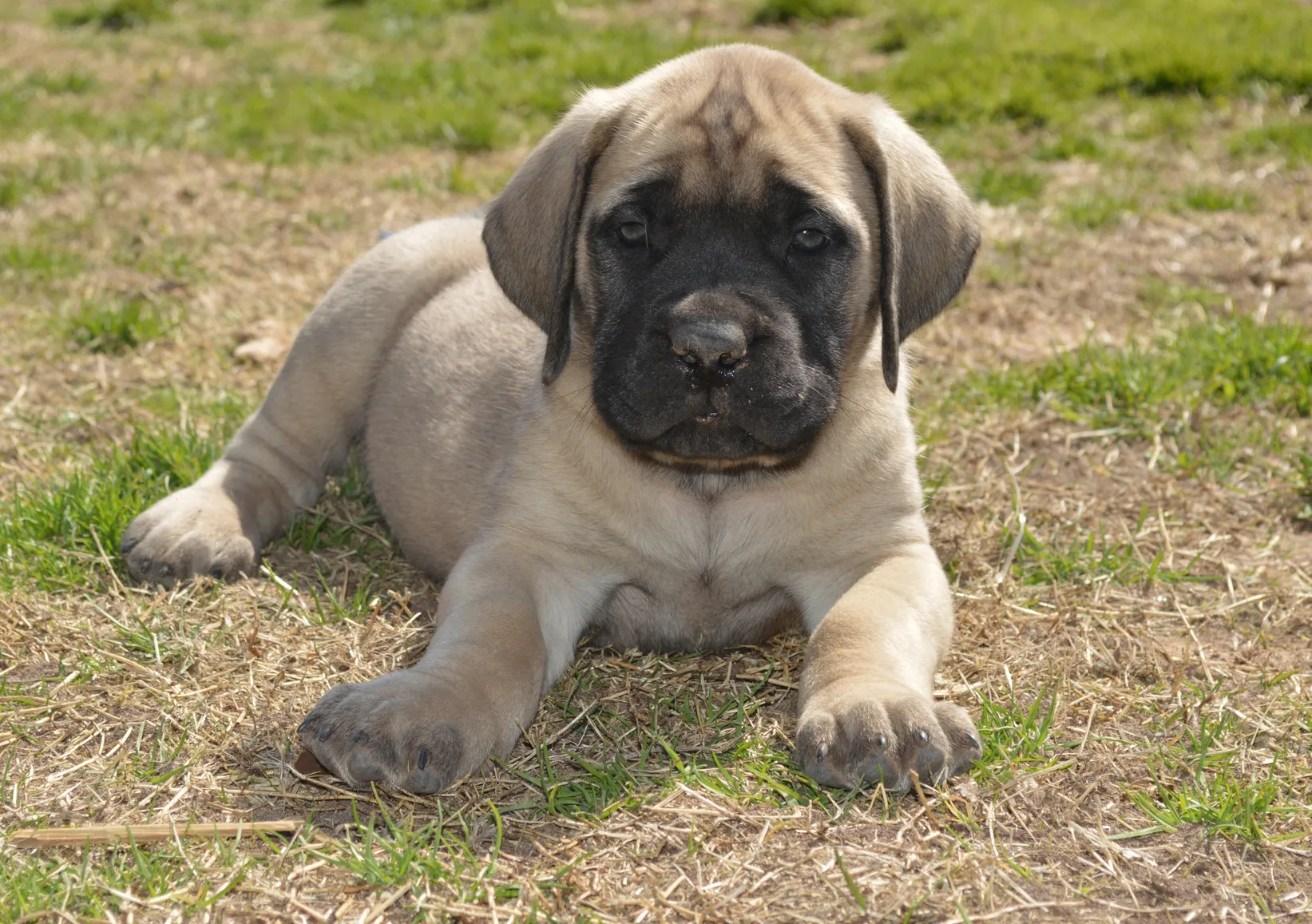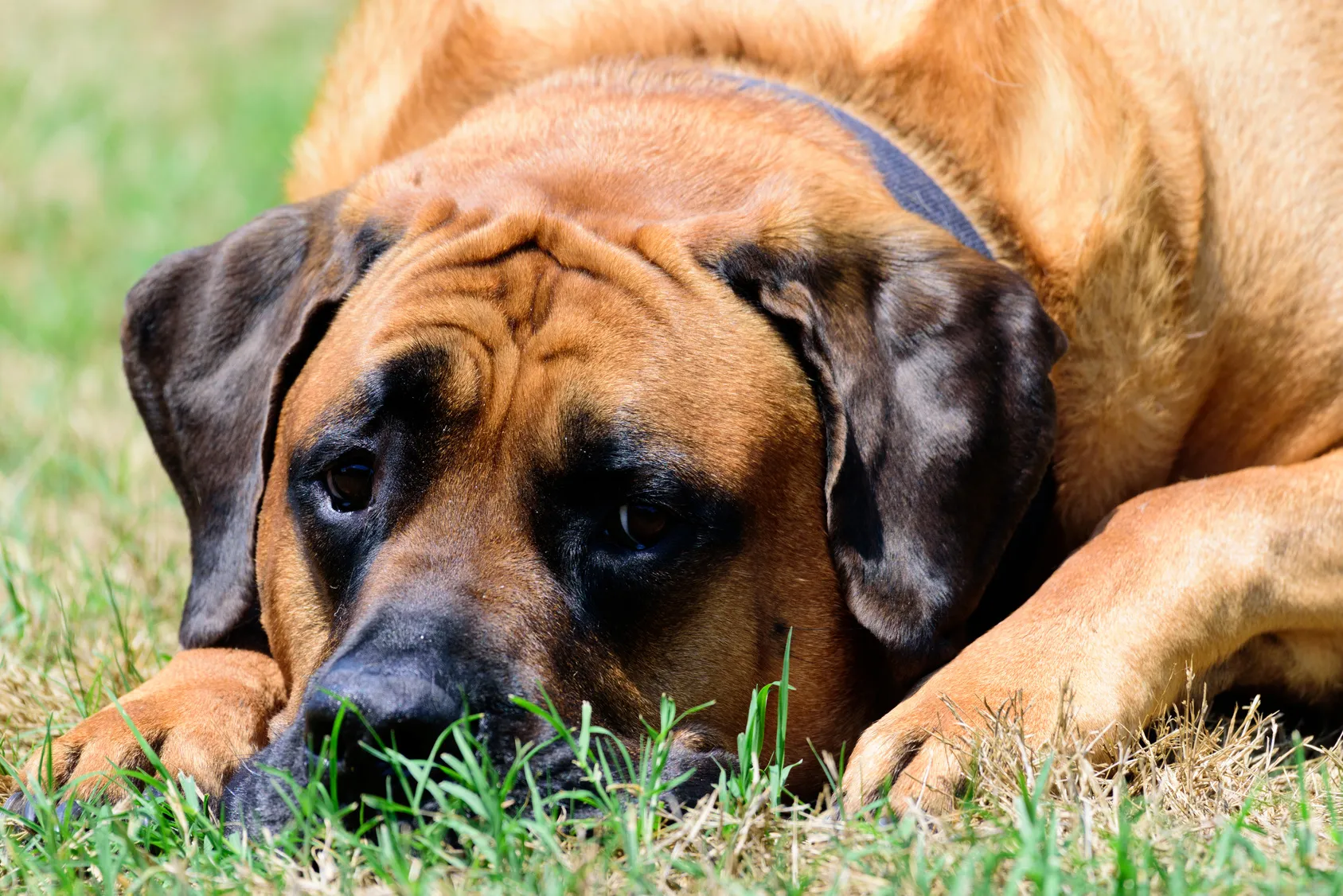Medium Size Poodle
In Stillness Lies Power: Despite its enormous body strength, the true strength of the English Mastiff does not lie in its muscles but in its calm and composed temperament. This large, massive dog carefully observes situations and prefers to respond cautiously to changes. Impulsive or even aggressive behaviour is entirely alien to this gentle giant.

© Waldemar Dąbrow / stock.adobe.com
The English Mastiff combines a gentle nature with an imposing appearance.
People can sometimes feel intimidated or apprehensive towards the breed. However, this is less about its temperament and more about its imposing appearance. Its “potential danger” is solely derived from its size and the associated power.
Undoubtedly, an English Mastiff with its broad jaw and mighty skull commands respect. Although there is no need to fear it, an enthusiastic jump can certainly have undesirable consequences. Therefore, it undoubtedly requires loving and consistent training and comprehensive socialisation to teach this large dog to assess and use its strength appropriately.
With a withers height of up to 90cm and a weight of up to 100kg, the English Mastiff is one of the largest and heaviest dogs in the world. The FCI breed standard, where the Mastiff is listed under number 264 (Group 2, Section 2: Molossoids), does not specify an exact weight for the breed. Size is indeed desirable, but only as long as it does not affect health.
According to the standard, size and weight must be in a “right proportion” to each other. The body of this large, massive dog must be well-proportioned and by no means overweight. The ideal Mastiff is large, massive, powerful and symmetrical, presenting a solid and harmonious overall image.
The Record Dog: The Mastiff male “Aicama Zorba La-Susa” weighed an impressive 155.58kg in November 1989 with a shoulder height of 95cm! This achievement earned him a place as the heaviest dog in the world in the “Guinness Book of Records”.
The Mastiff’s short and smooth fur lies close and highlights the muscles prominently. The hanging lips, high-set ears and wrinkled forehead when attentive give the Mastiff’s broad head its characteristic square appearance. The strongly muscled neck, which almost matches the head’s circumference, further reinforces the massive appearance.
The Mastiff comes in apricot, fawn or brindle colour variants. A dark colour around the nose, mouth and ears is explicitly desired and forms the typical mask for Mastiffs. Excessive white markings on the body, chest or feet are, however, not accepted.
The English Mastiff is distinguished by an exceptionally high stimulus threshold. Noise, stress or other animals cannot unsettle this composed dog. Its enviable calm, reserved nature and high sensitivity have earned the English Mastiff the nickname “gentle giant”. These traits make it a dog that is not only an excellent family dog but has also seen some success as a therapy dog.
Unlike its ancestors, which impressed in ancient arenas with their fearless fights against bears or bulls, the modern Mastiff has few combative traits. Contrary to the assumptions of some laypeople who mistake the dogs’ reserved nature for timidity, the English Mastiff is still a very brave dog today.
In situations where it perceives its loved ones’ safety to be seriously threatened, it would hesitate little to confront the aggressor. However, this powerful and large dog remains always composed. It would only truly attack and thereby seriously injure the aggressor in the most extreme emergency.
The combination of its imposing exterior, strong nerves and prudent actions makes it perfectly suited for its role as a watchdog, a role this British breed often holds.
Mastiffs are very closely bonded to their people, and their enormous body weight and size do not deter them from cuddling extensively with their loved ones.
 © BONNIE C. MARQUETTE / stock.adobe.com
© BONNIE C. MARQUETTE / stock.adobe.com
Thanks to its very people-oriented nature, Mastiffs are relatively easy to train and generally do whatever they can to please their humans. However, these intelligent dogs have retained a certain independence. Absolute obedience cannot be expected. But this disobedience never leads to rebellious or aggressive behaviour, making it generally not problematic for owners.
Due to its unshakeable calmness and love for people, living with an English Mastiff is very harmonious. In dealing with small children or elderly individuals, it proves to be an exceptionally empathetic companion. It also demonstrates remarkable tolerance towards other dogs or animals.
However, it takes some time for this close and intimate relationship with its people to form. The good-natured Mastiff may always be calm around strangers but remains somewhat distant. So, in matters of affection, an English Mastiff is very reserved, watching and assessing people carefully before it gives them its full love.
As well as a healthy diet and regular check-ups with the vet, plenty of exercise is essential for the health of the Mastiff. Ideally, a house with a large garden where it can romp around freely suits a dog of its size. This, of course, does not replace the daily joint walks.
Above all else, the English Mastiff treasures being close to its people. This affectionate dog always wants to be part of the family and is, therefore, entirely unsuitable for kennel living.
Mastiffs are very affectionate. Therefore, its handler should always remain calm and loving during training and give lots of praise. Loud, shouting commands can deeply unsettle this harmony-loving dog. Despite its good-natured and people-oriented disposition, an English Mastiff needs consistent training that clearly outlines what is expected of it. From the beginning, objectives should be clearly defined. Inconsistent actions confuse the dog.
An all-encompassing socialisation during puppyhood also contributes to fostering its calm demeanour. As a buyer, ensure that the young Mastiff is exposed to other dogs, cats, children, joggers and cyclists from an early age. The more experiences it has as a puppy, the less likely it will be startled or react unexpectedly later on.
A well-socialised and trained English Mastiff is, despite its size, relatively easy to care for. Its unshakeable composure, child-friendliness and peaceful protective instinct make it, in addition to being suitable as a watchdog and therapy dog, a loyal family pet with a huge heart.
 © Jennifer / stock.adobe.com
© Jennifer / stock.adobe.com
The size alone will undoubtedly deter some dog lovers from purchasing a Mastiff. After all, such a giant needs a lot of space. However, the coat care for the English Mastiff is minimal. Simple brushing is enough to keep its smooth, short fur clean. The English Mastiff enjoys these “pettings” to the fullest.
Special attention is needed for the dog’s skin folds, where parasites and dirt can easily settle. Regular checks and cleanings are essential to prevent infections.
The English Mastiff is considered a very robust breed with few hereditary diseases. Nevertheless, some representatives, like many other large dogs, suffer from hip joint problems (HD). Occasionally, heart diseases are also known.
Mastiffs are also prone to stomach torsion. To prevent this, serve several small portions throughout the day rather than one large meal. Generally, as with humans, a balanced diet contributes to the dog’s health.
Since Mastiffs already carry enough kilos, it’s crucial to ensure they don’t become overweight. After all, obesity not only makes them sluggish and lethargic but also stresses the bone structure. This can lead to other health problems.
Besides weight, other factors like age, health condition and activity level play a role. The diet should be tailored to your dog’s individual needs.
In addition to dry– and wet food, BARF (biologically appropriate raw feeding) is also a suitable feeding method. To determine your dog’s exact nutritional needs, it’s advisable to consult your trusted vet.
The colour of the English Mastiff caused some disagreements among experts throughout history, besides other external features. This likely relates to the fact that the Mastiff’s exact ancestry remains unclear to this day.
In the Roman Empire, heavy dogs resembling today’s Mastiff type at least outwardly were said to have served as fighting and war dogs. Celts and Normans are believed to have brought them to Britain, the Mastiff breed’s homeland.
Another theory suggests that the English Mastiff is a direct descendant of the Molosser, which arrived in England on trade ships from Epirus and Macedonia. Others claim the Mastiff descended from the Tibetan Mastiff. Earlier sources view the Mastiff as an autochthonous dog breed, meaning a breed that developed entirely naturally without targeted breeding by humans. However, the link to the Tibetan Mastiff has largely been disproven.
 © Thomas Foldes / stock.adobe.com
© Thomas Foldes / stock.adobe.com
Even if the ancestors’ history in antiquity is not fully clarified, the breed’s course can be traced at least from the Middle Ages. The Mastiff name first appeared in the 14th century in a treatise by the first Duke of York, Edmund of Langley. However, it’s worth noting that originally all massive dogs with a broad mouth and a square skull in England were called “Mastiffs”.
It’s certain that Mastiff-type dogs were widely used in the Middle Ages, especially in Great Britain. They were mentioned as war dogs, guard dogs, hunting dogs and fighting dogs. The first record of a Mastiff as a “war dog” is in the account of the Battle of Agincourt in 1415. One of these massive dogs reportedly stood loyally by its severely wounded master and protected him from further attacks.
In the upper class, the powerful dogs were popular hunting companions for bear or wild boar hunts. Mainly, however, they served as entertainment for the public in organised bear and bull fights in the Middle Ages. In the 16th century, arenas were specifically created around London for this purpose. During the so-called “Bear and Bullbaiting”, Mastiffs (and other large dogs) had to fight bears, lions, bulls and other predators.
The cruel career as fighting dogs ended only in 1835 when the British government finally banned these bloody spectacles. Around the same time, deliberate breeding of the Old English Mastiff began in England. In 1872, the first Mastiff Club was founded, and they began crossbreeding with smooth-coated Saint Bernards, which added more gentleness and balance to the character of the English Mastiff.
This did not stop the Mastiff breed from nearly disappearing after animal fights were banned. During both World Wars, the breed even faced extinction. Few could afford to feed such massive dogs during the hard war years. Thanks to Canada and the USA supporting the breed where a few specimens survived, breeding in Great Britain could resume post-war.
The Old English Mastiff is now considered one of the largest and oldest dog breeds in the world and the progenitor of several other large breeds like the Great Dane, Newfoundland, Bullmastiff and Saint Bernard. Unlike its relatives, the English Mastiff, aside from in its homeland England, is an extremely rare breed today.
If you like the English Mastiff, you might also be interested in these dog breeds:
Fans of the Bearded Collie agree that those who aren't familiar with this dog breed simply have to get acquainted with it. And those who have experienced how a Bearded Collie bolts across meadows with its flowing fur, how it rolls around full of energy and joy and how it attentively and observantly takes into account its owners wishes become simply addicted to this original dog breed and its unique charm.
The Goldendoodle isn't a breed, but a pairing between Golden Retrievers and Medium or Standard Poodles. Marketed as a low-maintenance dog for allergy sufferers, this hybrid is enjoying increasing popularity amongst dog lovers, similar to the Labradoodle.